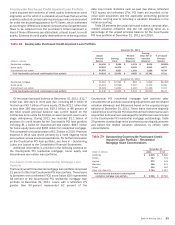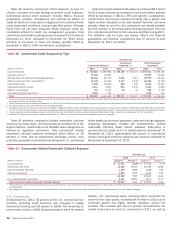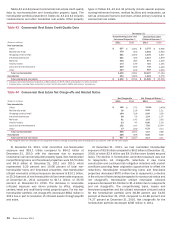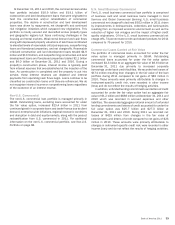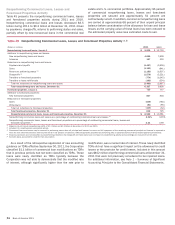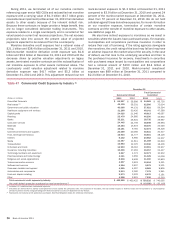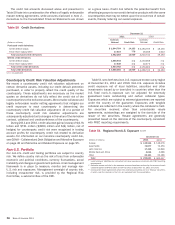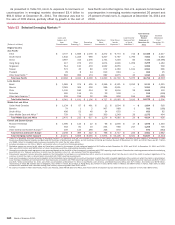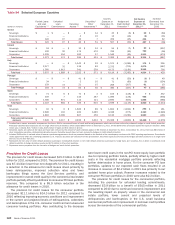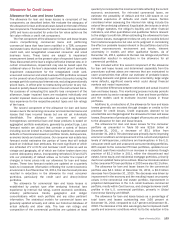Bank of America 2011 Annual Report Download - page 95
Download and view the complete annual report
Please find page 95 of the 2011 Bank of America annual report below. You can navigate through the pages in the report by either clicking on the pages listed below, or by using the keyword search tool below to find specific information within the annual report.Bank of America 2011 93
At December 31, 2011 and 2010, the commercial real estate
loan portfolio included $10.9 billion and $19.1 billion of
construction and land development loans that were originated to
fund the construction and/or rehabilitation of commercial
properties. The decline in construction and land development
loans was driven by repayments, net charge-offs and continued
risk mitigation initiatives which outpaced new originations. This
portfolio is mostly secured and diversified across property types
and geographic regions but faces continuing challenges in the
housing and rental markets. Weak rental demand and cash flows
along with depressed property valuations of land have contributed
to elevated levels of reservable criticized exposure, nonperforming
loans and foreclosed properties, and net charge-offs. Reservable
criticized construction and land development loans totaled $4.9
billion and $10.5 billion, and nonperforming construction and land
development loans and foreclosed properties totaled $2.1 billion
and $4.0 billion at December 31, 2011 and 2010. During a
property’s construction phase, interest income is typically paid
from interest reserves that are established at the inception of the
loan. As construction is completed and the property is put into
service, these interest reserves are depleted and interest
payments from operating cash flows begin. Loans continue to be
classified as construction loans until they are refinanced. We do
not recognize interest income on nonperforming loans regardless
of the existence of an interest reserve.
Non-U.S. Commercial
The non-U.S. commercial loan portfolio is managed primarily in
GBAM. Outstanding loans, excluding loans accounted for under
the fair value option, increased $23.4 billion in 2011 from
continued growth in corporate loans and trade finance due to client
demand, enterprise-wide initiatives, regional economic conditions
and disruption in debt and equity markets, along with the product
reclassification from U.S. commercial in 2011. For additional
information on the non-U.S. commercial portfolio, see Non-U.S.
Portfolio on page 98.
U.S. Small Business Commercial
The U.S. small business commercial loan portfolio is comprised
of business card and small business loans managed in Card
Services and Global Commercial Banking. U.S. small business
commercial net charge-offs declined $923 million in 2011 driven
by improvements in delinquencies, collections and bankruptcies
resulting from an improved economic environment as well as the
reduction of higher risk vintages and the impact of higher credit
quality originations. Of the U.S. small business commercial net
charge-offs, 74 percent were credit card-related products for 2011
compared to 79 percent for 2010.
Commercial Loans Carried at Fair Value
The portfolio of commercial loans accounted for under the fair
value option is managed primarily in GBAM. Outstanding
commercial loans accounted for under the fair value option
increased $3.3 billion to an aggregate fair value of $6.6 billion at
December 31, 2011 due primarily to increased corporate
borrowings under bank credit facilities. We recorded net losses of
$174 million resulting from changes in the fair value of the loan
portfolio during 2011 compared to net gains of $82 million in
2010. These amounts were primarily attributable to changes in
instrument-specific credit risk, were recorded in other income
(loss) and do not reflect the results of hedging activities.
In addition, unfunded lending commitments and letters of credit
accounted for under the fair value option had an aggregate fair
value of $1.2 billion and $866 million at December 31, 2011 and
2010 which was recorded in accrued expenses and other
liabilities. The associated aggregate notional amount of unfunded
lending commitments and letters of credit accounted for under the
fair value option was $25.7 billion and $27.3 billion at
December 31, 2011 and 2010. During 2011 we recorded net
losses of $429 million from changes in the fair value of
commitments and letters of credit compared to net gains of $23
million in 2010. These amounts were primarily attributable to
changes in instrument-specific credit risk, were recorded in other
income (loss) and do not reflect the results of hedging activities.


